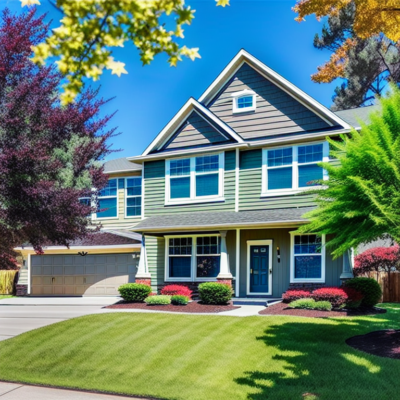Converting Your Property into a Multi-Residential Home
Kids Need Somewhere To Live? Have you Considered Your Basement?
As the demand for housing continues to rise in London, Ontario, many homeowners are exploring the possibility of converting their properties into multi-residential homes. Not only can this be a lucrative investment opportunity, but it also addresses the growing need for affordable housing options in the area. However, embarking on such a project requires careful planning, adherence to local zoning by-laws, and compliance with construction codes.
In this comprehensive guide, we will take an in-depth look at converting your property into a multi-residential home in London, Ontario. We will provide step-by-step instructions, practical tips, and important considerations specific to the area.
Additionally, we will highlight the significance of verifying all zoning by-laws and construction codes before commencing any work.

multi-generational investment property
>>>> Watch Us On YouTube
>>>> Follow Us On Instagram
>>>> Find Us On Facebook
MORE BLOG POSTS HERE >>>>Elevate Blog
Section 1: Understanding the Benefits of Converting Your Property
Converting your property into a multi-residential home offers several benefits. Firstly, it provides an opportunity for additional rental income, which can significantly boost your financial portfolio. Moreover, by catering to the demand for affordable housing, you contribute to the community’s well-being and address the ongoing housing crisis in London, Ontario. Additionally, this investment can provide long-term financial security and diversification of your real estate holdings.
Section 2: Researching Zoning By-laws and Regulations in London, Ontario
Before initiating any conversion project, thorough research of the local zoning by-laws and regulations is essential. This step ensures compliance with the city’s requirements and avoids potential legal issues. Start by accessing the official website of the municipality or city planning department, where you can find zoning maps, by-laws, and related information. Familiarize yourself with the requirements for multi-residential conversions, such as setbacks, parking, and density restrictions. It is crucial to review the specific zoning designation of your property to determine its suitability for multi-residential use.
Section 3: Ensuring Compliance with Construction Codes and Regulations
Complying with construction codes and regulations is vital to ensure your multi-residential home’s safety and structural integrity. Familiarize yourself with the Ontario Building Code, which outlines the minimum standards for construction, fire safety, plumbing, electrical systems, and accessibility. Engaging a professional architect or designer with experience in multi-residential conversions is highly recommended. They will guide you through the process, ensuring that your plans adhere to the local authorities’ codes and regulations.
Obtaining the necessary building permits is a critical step in the conversion process. Contact the municipality’s building department to inquire about the specific permits required for your project. This may include permits for demolition, renovation, plumbing, electrical work, and occupancy. Inspections will be conducted at various stages of the project to ensure compliance, and it is crucial to schedule these inspections promptly.
Section 4: Planning the Conversion Process
Proper planning is the foundation for a successful property conversion. Start by assessing the feasibility of your property for a multi-residential conversion. Consider factors such as the building’s size, layout, and structural integrity. Evaluate the number of units that can be accommodated while adhering to zoning and building regulations.
Next, create a comprehensive project plan outlining the conversion’s various phases, budgeting considerations, and realistic timelines. Identify the scope of work, including architectural modifications, plumbing and electrical upgrades, and interior finishes. Consider engaging a project manager to oversee the conversion process, ensuring efficient coordination of tasks and timely completion.
Documenting the project is crucial for legal and financial purposes. Keep a detailed record of all communication, contracts, invoices, and permits throughout the conversion process. This documentation will be valuable in the event of any disputes or inquiries in the future.
Section 5: Essential Considerations for Multi-Residential Home Conversions
Converting your property into a multi-residential home requires careful attention to specific considerations. Fire safety is paramount, so ensure the installation of smoke detectors, fire-rated doors, and adequate fire escape routes. Noise reduction techniques, such as soundproofing walls and floors, will contribute to the comfort and privacy of the occupants. Security measures like secure entrances, surveillance systems, and proper lighting should be implemented to ensure the safety of residents.
Additionally, familiarize yourself with accessibility requirements to ensure your multi-residential home accommodates individuals with disabilities. Install ramps or elevators where necessary, widen doorways, and provide accessible bathrooms and common areas. Adhering to energy-efficient practices, such as using energy-saving appliances, insulation, and efficient heating and cooling systems, will benefit the environment and help reduce operating costs for the property.
Conduct thorough market research to attract potential tenants and ensure a successful conversion. Identify the target demographic for your multi-residential home and tailor the design and amenities to suit their needs. Consider proximity to transportation, schools, shopping centers, and recreational facilities. Understanding the local rental market trends and pricing will help you set competitive rates.
Section 6: Engaging Professionals for a Smooth Conversion
Converting your property into a multi-residential home requires the expertise of various professionals. Engaging an architect or designer experienced in multi-residential conversions is crucial. They will help create functional floor plans, ensure compliance with building codes, and oversee the design and construction process.
Hiring a reputable contractor is essential for the execution of the project. Seek recommendations, review portfolios, and obtain multiple quotes to ensure you choose a contractor with a track record of delivering quality work on time and within budget. Also, consult with legal advisors specializing in real estate and property conversions to navigate legal complexities and ensure compliance with relevant laws and regulations.
Throughout the conversion process, clear communication between all parties involved is crucial. Regular progress meetings and updates with your architect, contractor, and other professionals will help ensure the project stays on track. Ensure that all contracts and agreements are in writing, clearly outlining the scope of work, timeline, and payment terms.
Conclusion and Final Considerations
Converting your property into a multi-residential home in London, Ontario, is an exciting opportunity to meet the demand for housing while maximizing your investment potential. However, it requires thorough research, adherence to local regulations, and collaboration with qualified professionals.
Before beginning any work, remember to verify all zoning by-laws and construction codes specific to your property. Seek guidance from the local municipality and engage professionals experienced in multi-residential conversions. With careful planning, attention to detail, and a focus on meeting the needs of potential tenants, you can embark on a successful conversion journey.
Keep in mind that this guide provides an overview of the conversion process. Still, consulting with experts and local authorities is essential to ensure compliance with current regulations and requirements. Investing time, effort, and resources into a well-executed conversion can transform your property into a profitable and valuable multi-residential home in London, Ontario.

Elevate Real Estate Group
Happy Home Buying or Selling
Are you thinking of making a move soon?
How can we elevate your real estate experience?
Potential Next Steps >>>
- Get a FREE online home evaluation: Free Home Evaluation
- Book a free in-home consultation: Contact Us
- Learn more about Elevate Real Estate Group: About Us
- Could you leave us a Google Review: Google Review
Want more details on the current market? You can find more information about the current market here: London & St Thomas Association of Realtors.



